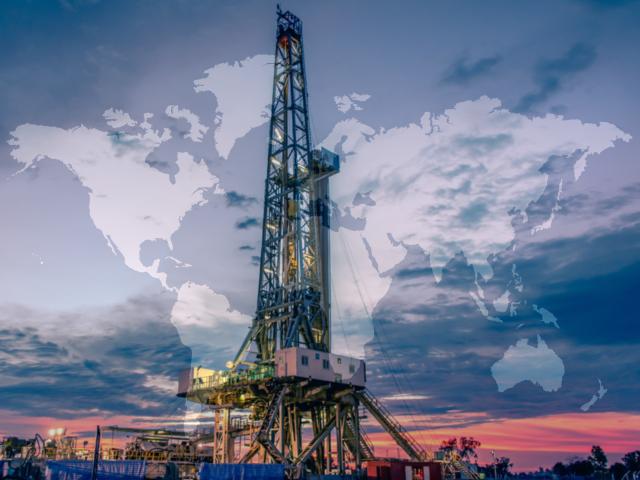
Russia, China and Argentina are among the top countries with significant oil and gas resources. (Source: Shutterstock.com)
[Editor's note: A version of this story appears in the May 2019 edition of Oil and Gas Investor. Subscribe to the magazine here.]
In the era of shale, operators working international opportunities frequently cast their eyes on the U.S. for expertise and analogs. The world’s top oil producers—ExxonMobil Corp., Chevron Corp., Royal Dutch Shell, BP Plc, Total SA, among others—have risen in the ranks of shale producers in recent years. Notably, large- and medium-sized independents remain dominant within North America.
Outside the U.S., shale development also has huge potential. Top countries with significant oil and gas resources include Russia, China and Argentina. Importantly, successful development of shale resources is highly dependent on geology, infrastructure and technical expertise. The relative youth of international shales means that there is still much to learn. Good analogues and direct know-how can fill this gap in understanding.
Recent examples of international shale development leveraging expertise from the U.S. include the Vaca Muerta in Argentina, the Sichuan Basin in China and the Bowland Shale in the U.K. Recent discoveries in Bahrain and Saudi Arabia suggest a potential tapping of U.S.’ shale expertise in the near future.
The Vaca Muerta is the most prolific unconventional source of oil and gas. YPF, the largest producer in the formation, jointly develops the shale with international major players, including Chevron, Equinor, Total, ExxonMobil and Shell. Notably, outside interests control about 46% of the acreage. Since 2015, YPF has collaborated with Schlumberger Ltd. in applying an unconventional fracture model, a model that helped optimize hydraulic fracture stimulations and increases flow rates with slickwater treatments.
Additionally, a YPF-Chevron joint venture (JV) in the Loma Campana Block makes use of advanced technologies to reduce costs and drilling time. Completed well costs are down from an estimated $8.7 million to $7.5 million. Drilling times improved by about 50%, driven by benefits from pad drilling. At the block, drilling now takes 20 to 22 days. Through JVs, YPF has also slashed completion and operating costs. In 2023, operating costs are expected to hit US$6 per barrel of oil equivalent.
In China, shale gas resources are abundant and rank among the top in the world. Technically recoverable shale gas was estimated at 1,115 trillion cubic feet (Tcf). However, the complexity of geology and poor infrastructure in mountainous terrain make it difficult to develop these shale blocks on a large scale. The most active foreign shale players include Shell, Chevron and Hess Corp. All have temporarily ceased exploration operations in southwest China, leaving BP as the only foreign company jointly developing China’s shale.
Recently, BP announced a significant discovery with the Wei 206-H1 well at the Neijiang Dazu Block in the Sichuan Basin. BP has a JV with CNPC (51% interest) to drill four horizontal wells at the block. BP, a top operator in the Haynesville Shale and Bossier play, where it is in development mode, drills wells with depths approaching 16,000 feet true vertical depth and lateral sections averaging about 7,500 feet. Given these depths, the Haynesville is a high-pressure, high-temperature environment, similar to conditions found downhole in Sichuan.
The Wei 206-H1 is the first probe to test gas potential in the block. The well, spudded in 2017 and drilled to a depth of 15,800 feet, can flow 353,000 cubic feet per day of natural gas. The expertise BP gained in the Haynesville in recent years could have direct application in Sichuan, where BP has three more horizontal wells to drill. Recent rumblings suggest better wells may be coming.
In Bahrain, a huge shale oil find was discovered in the shallow water of the western Persian Gulf. The largest shale oil resource ever found in Bahrain, it is estimated to hold at least 80 billion barrels of oil. So far, two appraisal wells have been drilled to test oil flow through fracking. However, fracking challenges have led Bahrain’s oil minister to major oil companies for potential collaboration. Hope is to reach an agreement this year. The majors possess both offshore and shale expertise, making them ideal partners for Bahrain.
In the U.K., the Bowland Shale contains 1,329 Tcf of gas in place, according to the British Geological Survey. Cuadrilla Resources announced positive flow results on its first well and continues to move forward in spite of headwinds. Stringent regulations on fracking and ongoing opposition remain high. Cuadrilla estimates initial flow rates from some Bowland Shale wells could reach 8 MMcf/d, referencing North American shale gas wells as an analogue. In February 2019, IGas Energy Plc made a discovery in the Bowland with an exploratory well, Springs Road-1. The exploration is a partnership with French operator Total, which also has expertise in drilling unconventional hydrocarbons in the U.S.
Other countries that have significant shale potential include Algeria, Mexico, Russia and Saudi Arabia. However, these countries are very early in shale and have much to learn about it. Consequently, more collaboration and exchange of know-how will surely come.
Recommended Reading
BP Restructures, Reduces Executive Team to 10
2024-04-18 - BP said the organizational changes will reduce duplication and reporting line complexity.
Matador Resources Announces Quarterly Cash Dividend
2024-04-18 - Matador Resources’ dividend is payable on June 7 to shareholders of record by May 17.
EQT Declares Quarterly Dividend
2024-04-18 - EQT Corp.’s dividend is payable June 1 to shareholders of record by May 8.
Daniel Berenbaum Joins Bloom Energy as CFO
2024-04-17 - Berenbaum succeeds CFO Greg Cameron, who is staying with Bloom until mid-May to facilitate the transition.
Equinor Releases Overview of Share Buyback Program
2024-04-17 - Equinor said the maximum shares to be repurchased is 16.8 million, of which up to 7.4 million shares can be acquired until May 15 and up to 9.4 million shares until Jan. 15, 2025 — the program’s end date.





